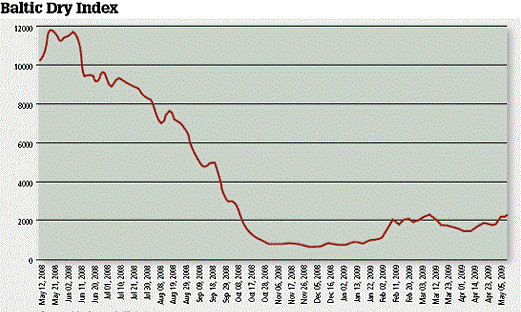
The international economy has been in the grip of the steepest decline in industrial production and trade since World War II. In my March 2009 column (“A Commodity-Price Snapback?”), I outlined an optimistic snapback scenario.
This was based, in part, on the Zarnowitz Rule (after the late Prof. Victor Zarnowitz, the University of Chicago’s pioneer in business cycle research). Prof. Zarnowitz observed that deep recessions tend to be followed by sharp recoveries.
In consequence, anything less than a sharp recovery in the USA will suggest that the interventionist policies of the Obama administration held back what should have been a natural, sharp recovery.
Virtually every economy in the world, including China, has taken a hit. But China is clearly bouncing back and will come close to meeting its 8% growth target for 2009.
Instead of engaging in the type of anti-capitalistic populism practiced by many politicians in western capitals, China’s Premier Wen Jiabao has been packing Adam Smith’s The Theory of Moral Sentiments in his luggage. The “party line” has been: free-markets, free-trade and stability. Beijing has matched its rhetoric with large purchases of commodities.
Commodity prices peaked at alarmingly high levels in midsummer 2008. They then fell sharply in the late summer and early autumn months, bottoming out in December. Since then, commodity prices have moved up. Indeed, Commodity Research Bureau’s Spot Index, which contains twenty-three commodities, is up by 16.5% since December 2008 (see the accompanying chart).

To obtain a better grasp of the dynamics of commodity markets, let’s take a look at the evolution of the oil and copper markets since June 2008. The accompanying table shows how the spot and 12-month futures prices have moved since last summer. With these prices, the term structure of interest rates for oil and copper can be calculated for specific dates. These commodity (or “own”) interest rates are also presented in the table.
Futures as commodity loans
Before interpreting the commodity interest rates, it is important to realize that futures markets operate as loan markets for commodities. As such, they operate in a manner that is similar to money markets.
When a handler of commodities purchases a commodity and simultaneously sells a futures contract, he is temporarily borrowing a commodity. This procedure is much like borrowing money from a bank with the promise to repay the loan in the future.
The sale of a futures contract, in conjunction with the purchase of a commodity in the spot market, allows a handler to borrow a commodity now and repay it later. These simultaneous buy-sell transactions are, therefore, implicit commodity loans.
If the price of a commodity for future delivery exceeds the spot (or cash) price, the market is in contango, and the commodity interest rate is negative. A lender of a commodity has no incentive to lend to the spot market because he would be in effect selling low and buying high.
The reverse occurs when the spot price exceeds the futures price and the market is in backwardation. Commodity interest rates are positive. In this case, it pays those who hold commodities to loan them to the spot market.
Prior to the financial and economic panic in the early autumn of 2008, oil and copper price levels were elevated and the markets were in backwardation. Accordingly, commodity interest rates were positive and it paid those who held inventories to loan them to the spot market. In short, the markets were “tight” and inventories were “scarce.”
With the onset of the panic, the demand for oil and copper fell sharply and the commodity interest rates switched from positive to negative. This switch from backwardation to contango indicated ample inventories relative to demand in the spot markets. Those who held inventories had no incentive to loan them to the spot market.
While the oil and copper markets remain in contango (inventories relative to spot demands are ample), the commodity interest rates are becoming less negative, indicating that these markets are “tightening up.”
This conclusion is also confirmed by the volatile Baltic Dry Index, which is a freight-rate benchmark for shipping dry commodities— like building materials, grains, coal and iron ore.
Since these commodities are raw material inputs used in production processes, the cost of moving them in bulk by ship is a precursor to industrial production. Since reaching dramatic lows in December 2008, the BDI has moved up by 240% (see the accompanying chart).


Gold a solution
China has played its cards smartly. that lends important weight to an optimistic recovery scenario. That said, Beijing’s comments about replacing the world’s reserve currency (the US dollar) with an artificial basket “currency” (the International Monetary Fund’s Special Drawing Rights) raise more questions than they answer.
Given China’s huge dollar-denominated foreign reserve war chest, Beijing has cause to be worried about the value of the dollar. But why jump from one fiat currency into a basket of four fiat currencies (the dollar, yen, euro and British pound)?
If Beijing wants an apolitical, stable international currency that is “disconnected from economic conditions and sovereign interests of any single country” – as Zhou Xiaochuan, governor of the People’s Bank of China, put it on March 23 – then gold is the answer.
Contrary to the Financial Times editorial “As Good As Gold” (May 8, 2009), the gold standard’s recent renaissance is not based on irrational worries about the international fiat monetary system. Those worries are rational, fact-based worries.
Author Steve H. Hanke

0 responses on "China’s Cards"